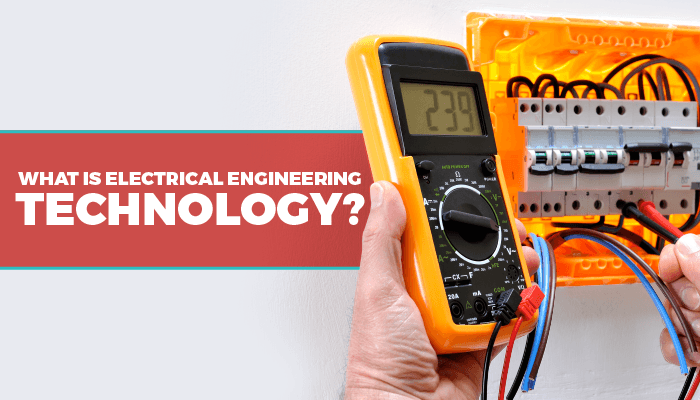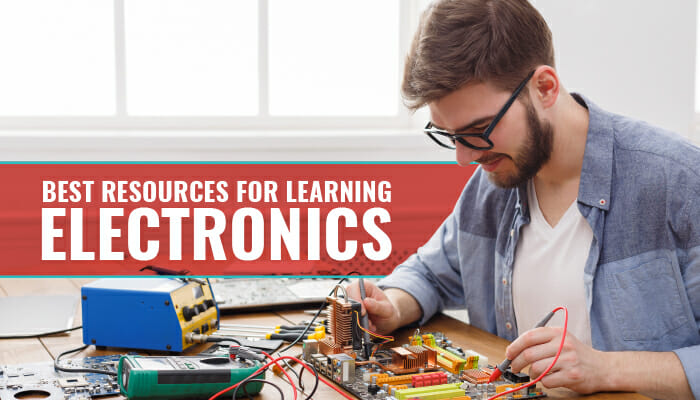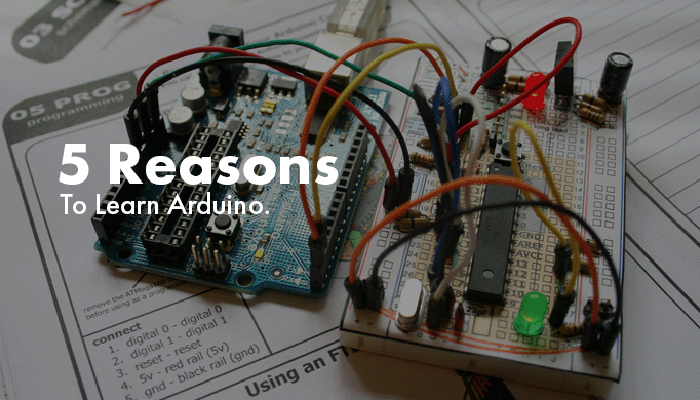Have you ever been interested in building or tinkering with electronics?
Does the idea of circuitry fascinate you?
If so, then you may be wondering how you can start learning electronics to begin working on machines, either as a hobby or as more of a professional interest.
Fortunately, it’s never been easier to get into this field, thanks to all of the various tools and tutorials at your disposal. Whereas in the old days you had to break apart electronics to understand how they work, now you can order pieces and construct them from scratch.
Today we’re going to be looking at the steps you should take to go from novice to pro. Don’t worry if you have no idea about anything electronics-related – we’re here to help.
Getting Started
Although we’re going to give you a step by step guide, feel free to skip any parts you know about already.
Our goal is to lower the bar of entry so that anyone with an interest in electronics can go from total newbie to building their first system, so we’ll keep it light on the jargon and heavy on the fun.
#1 Learn the Basics of Electricity
Before you can get started with any kind of electronic components, you should understand how electricity works.
Most people take it for granted, which means that they don’t know the difference between volts, amps, and ohms. In fact, depending on how familiar you are with the subject, we may have just blown your mind already.
When it comes to learning about electricity, you kind of have to learn all of the pieces together, rather than individually. Because a current consists of various elements, it’s better to know they interact with each other if you want to build from that foundation.
The first things to learn are volts, amps, watts, and ohms. Our Electronics 101 course is a great place to start learning these concepts.
In fact, we encourage you to seek out additional resources to answer any questions that come up during this process so that you can advance to the next step smoothly.
Voltage – the amount of energy flowing through an electrical system
Amps – the rate at which the energy flows, also known as the current
Watts – how much power is delivered to the endpoint
Ohms – the rate of resistance applied to the energy
For most people, the best way to understand how they work together is to think of them in terms of plumbing. The voltage is like the water in the system, amps are how much pressure is in the pipes, watts are how much water you get from the tap, and ohms is like the size of the tube itself.
As you can see, these elements interact all the time and knowing how they affect each other helps you understand circuitry and electronics so much better.
There is an equation called Ohm’s Law that helps you figure out how much current is flowing through a system.
It is I=V/R. I stands for current (amps), V is voltage and R is resistance (ohms).
So, a component that has 120 volts and 80 ohms will generate 1.5 amps.
To get from amps to watts, you have to multiply the amps by the volts. In this case, it would be 180 watts.
The equation looks like this W = AxV.
#2 Understand Circuitry Essentials
Once you know how electricity works, you can apply that knowledge to the circuits themselves. One of the fundamental systems to learn is the closed loop.
Without a closed loop, your circuit won’t work, so you have to understand it before you can move to the next step.
What’s great about knowing the elements of a closed loop is that you can apply it to all circuits. Even though there may be some complicated add-ons in there, the loop is still the same.
To put it simply, a closed loop works like this-
Electrons (the elemental component of electricity) flow from a positive charge to a negative charge. Their movement is what generates energy and allows us to use electronics. A closed loop is merely a connection between these terminals.
A simple real-world example would be to connect a light bulb to the positive and negative ends of a battery with a wire. As the electrons move from one point to the other, they allow the light to shine.
Other circuitry essentials include resistors and transistors. We won’t go into too much detail, but resistors set the amount of resistance (ohms) in a circuit, and a transistor allows you to manage the current (amps).
They are not producing the energy, but they help you control how it flows from the positive to the negative terminal.
A good example of this would be to add a switch to your light bulb so that you can turn it on or off, or adjust the amount of energy going to the bulb itself (dimmer switch).
There are other components involved in circuitry, such as capacitors and diodes. You should look at a complete list and understand how each element works and how it can affect other parts of a circuit.
#3 Learn to Read Diagrams
Circuitry diagrams are like a blueprint for a building. They show how the circuit works and the components included. At first, they may seem complicated, but they are simply built from a variety of fundamental elements that we’ve already covered.
The best thing to do would be to learn the individual marks (i.e., resistor, battery, capacitor, etc.) and then start with simplified schematics.
Once you can begin to read the diagram without having to refer to your list of terms, then you know that you’re ready to start applying your knowledge to the real thing.
Also, you should learn how to draw circuit diagrams from scratch. Being able to do this will help you when it comes to building a circuit, so having this kind of experience will make the process even smoother.
#4 Play With Elements of Circuitry
Reading about diodes and transistors is one thing, but it’s entirely different to see them up close and use them in a circuit. Once you’ve mastered the abstract concepts and you can create diagrams, now is the time to work on the real elements.
You can buy circuitry parts online and start playing with them. We suggest that you first use your diagrams to build a circuit without a breadboard.
This will help solidify your knowledge and make creating your first circuit even easier. It will also help you understand how to get these parts for future projects.
#5 Build a Working Circuit
Once you have your parts ready, now you want to start with a simple closed loop. Using a breadboard, create a circuit that can power an LED bulb. Since this is the easiest one to make, it will serve as the foundation for the rest of your curriculum. Remember, all circuits have the same elements, so it’s only a matter of adding different parts to achieve particular goals.
Once you have mastered the closed loop and you can illuminate lights, you’re ready for the next step.
#6 Create a Switch
Although it may seem simple enough to add a switch to your light, it’s a little more complicated than you may think. Because a switch has different elements and it has multiple functions (at least two, on and off), you have to build the circuit with that in mind.
An on/off switch is a great starting point in learning electronics, but you can also mess around with different switches, such as a dimmer or a timed switch. Adding these elements will help you understand what it takes to create more complex circuits.
One thing we should mention is that it’s a good idea to draw diagrams of all of these circuits before building them. While you can skip that step, it will help reinforce the concepts so that you can master them even faster.
#7 Learn Soldering
Breadboards are great for learning electronics because they allow you to create simple circuits without a lot of technical expertise.
However, if you want to work with electronics, you have to build more permanent solutions, which requires a soldering iron.
Soldering your circuit elements will allow you to make boards that can be inserted into a device without having the components fall out (as they would in a breadboard).
Thus, learning to solder will be necessary if you want to graduate to more complex projects.
When taking up this skill, you should practice as much as you can before applying it to the real thing. Soldering your circuit incorrectly will make the whole thing worthless, so it’s better to get it right beforehand.
This is also where drawing diagrams helps because you can visualize how the components will fit together before committing to it.
#8 Upgrade to Integrated Circuitry
Integrated circuits are those that are made to fit onto a chip. Essentially, you’re creating closed loops that are part of a larger system.
For example, you can have one chip that acts as a switch and another that lets you add more power to the system. Think of it as a volume knob on a radio.
Once you know how to build integrated circuits, you are almost ready to start building complex electronics.
Again, don’t overthink things. Build each chip with the same method you’ve been using and utilize diagrams to make sure that you know where everything is supposed to go.
#9 Design and Execute a Circuit Board
Unless you have a factory in your home, it will be very difficult to build a circuit board from scratch.
To build a circuit board, you have to invest in a program that lets you draw schematics on the computer and convert them to a board layout.
You can print the plan to make sure that it will fit into your housing unit, but you will have to send that file to a manufacturer to get the final product.
There are several circuit board makers out there, and they can cost as little as $1 for each one, making them a viable investment.
But if you are up for the challenge… why not try and create your own from scratch?!
#10 The Best Way To Learn? Find a Passion Project and Build It
Once you’ve begun building your circuit boards, now you can start creating your own electronics! The best thing to do for learning electronics is to find a particular item that you want to build and break it down into the various components you’ll need.
Then, go step by step from planning to execution and see how well you do. Once you put it all together and it works, you’re ready for anything!
Have a passion project that you want us to write about? Tell us in the comment section!
More Projects You Might Enjoy
Mechanical Engineering Projects From Beginner To Advanced
10 Cool And Challenging Engineering Projects For Kids
The Ultimate List Of Engineering Projects
More Tutorials You Might Enjoy
Best Resources For Learning Electronics
10 Simple Steps To Learning Electronics
How To Use A Breadboard With Other Components



